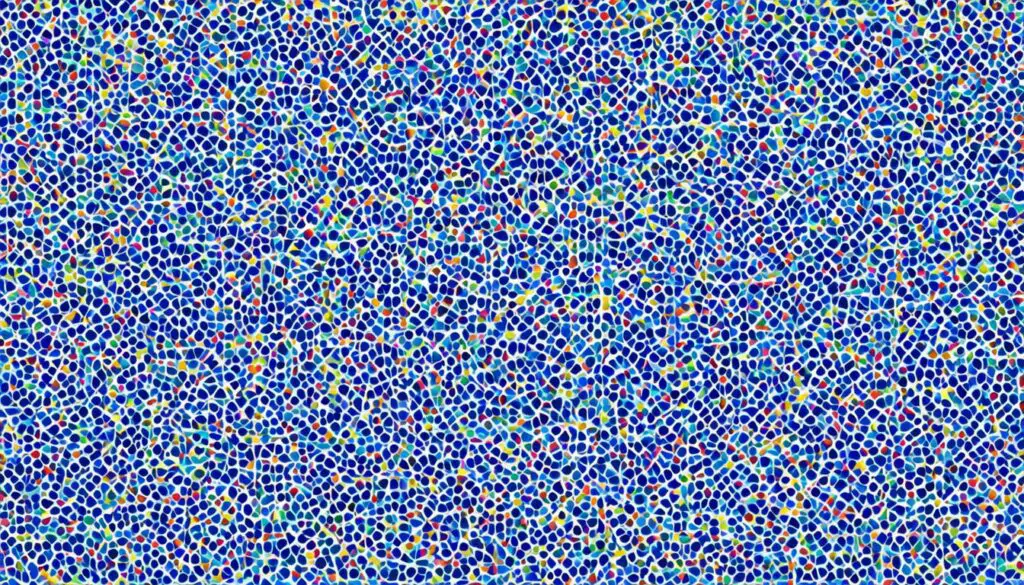Welcome to my blog post on Principal Component Analysis (PCA). It’s a powerful tool in data analysis and simplifying large data sets. Here, we’ll explore the core concepts of PCA. We’ll see how it finds hidden patterns, makes data simpler, and easier to understand.
PCA is great for breaking down complex data. It reduces the size of large datasets without losing key info. This makes big data easier to understand, benefiting fields like machine learning and computer vision.

Key Takeaways:
- PCA is a statistical technique used for data analysis and dimensionality reduction.
- It uncovers hidden patterns in data and simplifies complex data structures.
- PCA finds applications in fields such as machine learning and computer vision.
- By reducing dimensions while retaining important information, PCA improves data interpretability.
- PCA enhances comprehension and insight by identifying meaningful relationships in the data.
Key Concepts in PCA
In this section, I’ll cover the main ideas of Principal Component Analysis (PCA). Knowing these key concepts helps us understand PCA better. PCA is used in many areas. So, it’s good to look closely at each concept.
Dimensionality Reduction
In PCA, we cut down the number of variables in a dataset. This is called dimensionality reduction. It keeps the most important information. We do this to simplify data and make calculations faster. PCA creates new variables, which are the principal components, from the original data.
Orthogonal Transformation
PCA changes the data through an orthogonal transformation. It turns the old variables into a new, orthogonal set defined by the principal components. ‘Orthogonal’ means the axes are at right angles to each other. This change helps PCA find and use the most variation within the data.
Eigenvalues and Eigenvectors
Eigenvalues and eigenvectors are key to understanding PCA. They’re linked to the principal components. Eigenvalues show how much variance each principal component explains. Eigenvectors show their direction in the dataset’s space. Larger eigenvalues mean more essential information is kept by that principal component.
Variance Explained
Understanding variance explained tells us what portion of the data’s variation is kept by each principal component. It helps us see how important each component is. Higher variance explained values mean the component captures a lot of the dataset’s variety.
Knowing these PCA concepts sets a strong base for looking at its real-world uses. Let’s jump into the interesting applications of PCA in the next part.
Applications of PCA
PCA is a technique used in many fields to simplify data analysis. Let’s see where it’s essential:
Data Compression
It’s great for shrinking data size and saving storage space. PCA turns complex data into simpler forms. This way, it keeps the main info and drops what’s not as important. It helps big data processes run more smoothly.
Noise Reduction
Real-world data often has extra noise. PCA can spot the noise and filter it out. It picks out the main data patterns, improving data quality. This makes analysis more reliable.
Feature Extraction
PCA is key in finding the most important parts of the data. It pulls out the key features from a mess of data. These features show the main patterns in the information. Using PCA makes later data processing easier and models work better.
Exploratory Data Analysis
In understanding data, PCA is your friend. It helps spot trends and groups in the data. Showing data visually, PCA aids in making sense of complex information. This helps in making better choices and planning further studies.
Image Recognition and Computer Vision
For computer vision, PCA is vital. It simplifies the image data without losing the main visuals. By working with main image principles, it makes tasks quicker and more accurate. Thus, improving how machines see and understand images.
PCA is useful in many ways, aiding in data handling and analysis improvement. Its benefits span from reduced storage needs to clearer insights. Using PCA smartly can lead to better understanding and decision-making.

Conclusion
Principal Component Analysis (PCA) is great for cutting through data complexity. It makes big datasets easier to understand by finding patterns. This is useful in fields like machine learning, data science, and computer vision.
PCA is awesome because it can make complex data simpler without losing key details. This helps in making better decisions from the data. It allows analysts to pull out the most important parts for understanding.
PCA does a lot, from making data smaller to finding signals in the noise. It helps in many ways, changing how we deal with complex data. This impacts industries and disciplines in a big way by shedding light on hidden insights.
So, PCA is key for getting key info from complex data simply. Its wide reach changes the game for various professions. It helps spot important patterns, decide smarter, and understand data on a deeper level.
FAQ
What is Principal Component Analysis (PCA)?
PCA stands for Principal Component Analysis. It’s a powerful tool for data analysis and cutting down on the number of features. This method makes complex data easier to understand by finding hidden patterns. It simplifies the data structure, allowing for better analysis.
What does PCA do?
PCA reduces the number of dimensions in a data set. It keeps the important data and simplifies the structure. This simplification helps us understand the data better and finds any hidden patterns.
What are the key concepts in PCA?
The main ideas include making data simpler, using special math to change data, and important values for showing data changes. By making the data simpler, we keep the most essential information. The special math changes the data so that it’s easier to understand, and it helps find patterns. The important values show us how much each change really tells us about the data.
What are the applications of PCA?
PCA is useful in many areas. It can compress data, which is handy for saving storage space and cutting costs. It’s great for getting rid of noise in the data too. Another use is to pick out the most important parts of high-dimensional data for more study. This helps in spotting patterns and links in the data. For things like recognizing images, PCA is used to make the data simpler, without losing its meaning.






